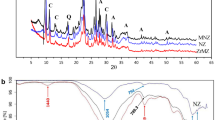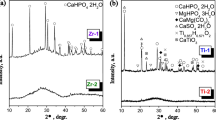Abstract
Background
Phosphate (PO43−) is the main etiological factor of eutrophication in surface waters. Metal organic frameworks (MOFs) are novel hybrid materials with amazing structural properties that make them a prominent material for adsorption.
Methods
Zeolitic imidazolate framework 67 (ZIF-67), a water stable member of MOFs, with a truncated rhombic dodecahedron crystalline structure was synthesized in aqueous environment at room temperature and then characterized using XRD and SEM. PO43− adsorption from synthetic solutions using ZIF-67 in batch mode were evaluated and a polynomial model (R2: 0.99, R2adj: 0.98, LOF: 0.1433) developed using response surface methodology (RSM).
Results
The highest PO43− removal (99.2%) after model optimization obtained when ZIF-67 dose, pH and mixing time adjusted to 6.82, 832.4 mg/L and 39.95 min, respectively. The optimum PO43− concentration in which highest PO43− removal and lowest adsorbent utilization occurs, observed at 30 mg/L. PO43− removal eclipsed significantly in the presence of carbonate. The equilibrium and kinetic models showed that PO43− adsorbed in monolayer (qmax: 92.43 mg/g) and the sorption process controlled in the sorption stage. Adsorption was also more favorable at higher PO43− concentration, according to the separation factor (KR) graph. Thermodynamic parameters (minus signs of ∆G°, ∆H° of 0.179 KJ/mol and ∆S° of 44.91 KJ/mol.K) demonstrate the spontaneous, endothermic and physisorption nature of the process.
Conclusion
High adsorption capacity and adsorption rates, make ZIF-67 a promising adsorbent for PO43− removal from aqueous environment.







Similar content being viewed by others
References
Sun Y, Sun Q, Huang H, Aguila B, Niu Z, Perman JA, et al. A molecular-level superhydrophobic external surface to improve the stability of metal–organic frameworks. J Mater Chem A. 2017;5(35):18770–6.
Stock N, Biswas S. Synthesis of metal-organic frameworks (MOFs): routes to various MOF topologies, morphologies, and composites. Chem Rev. 2011;112(2):933–69.
Shams M, Dehghani MH, Nabizadeh R, Mesdaghinia A, Alimohammadi M, Najafpoor AA. Adsorption of phosphorus from aqueous solution by cubic zeolitic imidazolate framework-8: modeling, mechanical agitation versus sonication. J Mol Liq. 2016;224:151–7.
Yin Z, Wan S, Yang J, Kurmoo M, Zeng M-H. Recent advances in post-synthetic modification of metal–organic frameworks: New types and tandem reactions. J Coord Chem. 2017;In Press.
Li S, Zhang X, Huang Y. Zeolitic imidazolate framework-8 derived nanoporous carbon as an effective and recyclable adsorbent for removal of ciprofloxacin antibiotics from water. J Hazard Mater. 2017;321:711–9.
Zhang L, Su Z, Jiang F, Yang L, Qian J, Zhou Y, et al. Highly graphitized nitrogen-doped porous carbon nanopolyhedra derived from ZIF-8 nanocrystals as efficient electrocatalysts for oxygen reduction reactions. Nanoscale. 2014;6(12):6590–602.
Chaikittisilp W, Hu M, Wang H, Huang H-S, Fujita T, Wu KC-W, et al. Nanoporous carbons through direct carbonization of a zeolitic imidazolate framework for supercapacitor electrodes. Chem Comm. 2012;48(58):7259–61.
Li J, Zhu Q-L, Xu Q. Pd nanoparticles supported on hierarchically porous carbons derived from assembled nanoparticles of a zeolitic imidazolate framework (ZIF-8) for methanol electrooxidation. Chem Comm. 2015;51(54):10827–30.
Hao L, Wang C, Wu Q, Li Z, Zang X, Wang Z. Metal–organic framework derived magnetic nanoporous carbon: novel adsorbent for magnetic solid-phase extraction. Anal Chem. 2014;86(24):12199–205.
Jian M, Liu B, Zhang G, Liu R, Zhang X. Adsorptive removal of arsenic from aqueous solution by zeolitic imidazolate framework-8 (ZIF-8) nanoparticles. Colloids Surf A Physicochem Eng Asp. 2015;465:67–76.
Liu B, Jian M, Liu R, Yao J, Zhang X. Highly efficient removal of arsenic (III) from aqueous solution by zeolitic imidazolate frameworks with different morphology. Colloids Surf A Physicochem Eng Asp. 2015;481:358–66.
Yan X, Hu X, Chen T, Zhang S, Zhou M. Adsorptive removal of 1-naphthol from water with Zeolitic imidazolate framework-67. J Phys Chem Solids. 2017;107(8):50–4.
Yong P, Zhi L, Zhe Z, Xiong-Shi T, Hai L, Chong-Zhi J, et al. Adsorptive removal of phenol from aqueous solution with zeolitic imidazolate framework-67. J Environ Manag. 2016;169(169):167–73.
Huang Y, Zeng X, Guo L, Lan J, Zhang L, Cao D. Heavy metal ion removal of wastewater by zeolite-imidazolate frameworks. Sep Purif Technol. 2018;194:462–9.
Liu J, Wu Y, Wu C, Muylaert K, Vyverman W, Yu H-Q, et al. Advanced nutrient removal from surface water by a consortium of attached microalgae and bacteria: a review. Bioresour Technol. 2017;241:1127–37.
Mahvi AH. Ebrahimi SJA-d, Mesdaghinia a, Gharibi H, Sowlat MH. Performance evaluation of a continuous bipolar electrocoagulation/electrooxidation–electroflotation (ECEO–EF) reactor designed for simultaneous removal of ammonia and phosphate from wastewater effluent. J Hazard Mater. 2011;192(3):1267–74.
Rafati L, Nabizadeh R, Mahvi AH, Dehghani MH. Removal of phosphate from aqueous solutions by iron nano-particle resin Lewatit (FO36). Korean J Chem Eng. 2012;29(4):473–7.
Khalil AM, Eljamal O, Amen TW, Sugihara Y, Matsunaga N. Optimized nano-scale zero-valent iron supported on treated activated carbon for enhanced nitrate and phosphate removal from water. Chem Eng J. 2017;309:349–65.
Khazaei M, Nabizadeh R, Mahvi AH, Izanloo H, Ansari Tadi R, Gharagazloo F. Nitrogen and phosphorous removal from aerated lagoon effluent using horizontal roughing filter (HRF). Desalin Water Treat. 2016;57(12):5425–34.
Yousefi N, Fatehizedeh A, Ghadiri K, Mirzaei N, Ashrafi SD, Mahvi AH. Application of nanofilter in removal of phosphate, fluoride and nitrite from groundwater. Desalin Water Treat. 2016;57(25):11782–8.
Malakootian M, Yousefi N, Fatehizadeh A, Van Ginkel SW, Ghorbani M, Rahimi S, et al. Nickel (II) removal from industrial plating effluent by Fenton process. Environ Eng Manag J. 2015;14(4):837–42.
Ahmadian M, Yosefi N, Toolabi A, Khanjani N, Rahimi S, Fatehizadeh A. Adsorption of Direct Yellow 9 and Acid Orange 7 from Aqueous Solutions by Modified Pumice. Asian J Chem. 2012;24(7).
Pourfadakari S, Yousefi N, Mahvi AH. Removal of reactive red 198 from aqueous solution by combined method multi-walled carbon nanotubes and zero-valent iron: equilibrium, kinetics, and thermodynamic. Chin J Chem Eng. 2016;24(10):1448–55.
Rezaee R, Maleki A, Jafari A, Mazloomi S, Zandsalimi Y, Mahvi AH. Application of response surface methodology for optimization of natural organic matter degradation by UV/H2O2 advanced oxidation process. J Environ Health Sci Eng. 2014;12(1):67.
Arslan A, Topkaya E, Bingöl D, Veli S. Removal of anionic surfactant sodium dodecyl sulfate from aqueous solutions by O3/UV/H2O2 advanced oxidation process: process optimization with response surface methodology approach. Sustain Environ Res. 2017;28(2):65–71.
Im J-K, Cho I-H, Kim S-K, Zoh K-D. Optimization of carbamazepine removal in O3/UV/H2O2 system using a response surface methodology with central composite design. Desalination. 2012;285:306–14.
Guo X, Xing T, Lou Y, Chen J. Controlling ZIF-67 crystals formation through various cobalt sources in aqueous solution. J Solid State Chem. 2016;235:107–12.
Qu J, Meng X, You H, Ye X, Du Z. Utilization of rice husks functionalized with xanthates as cost-effective biosorbents for optimal cd (II) removal from aqueous solution via response surface methodology. Bioresour Technol. 2017;241:1036–42.
Du X-D, Wang C-C, Liu J-G, Zhao X-D, Zhong J, Li Y-X, et al. Extensive and selective adsorption of ZIF-67 towards organic dyes: performance and mechanism. J Colloid Interface Sci. 2017;506:437–41.
Dehghan A, Zarei A, Jaafari J, Shams M, Khaneghah AM. Tetracycline removal from aqueous solutions using zeolitic imidazolate frameworks with different morphologies: a mathematical modeling. Chemosphere. 2018.
Qasemi M, Afsharnia M, Zarei A, Najafpoor AA, Salari S, Shams M. Phenol removal from aqueous solution using Citrullus colocynthis waste ash. Data Brief. 2018;18:620–8.
Yoon H-S, Chung KW, Kim C-J, Kim J-H, Lee H-S, Kim S-J, et al. Characteristics of phosphate adsorption on ferric hydroxide synthesized from a Fe 2 (SO 4) 3 aqueous solution discharged from a hydrometallurgical process. Korean J Chem Eng. 2018;35(2):470–8.
Xiong W, Tong J, Yang Z, Zeng G, Zhou Y, Wang D, et al. Adsorption of phosphate from aqueous solution using iron-zirconium modified activated carbon nanofiber: performance and mechanism. J Colloid Interface Sci. 2017;493:17–23.
Fang L, Wu B, Lo IM. Fabrication of silica-free superparamagnetic ZrO2@ Fe3O4 with enhanced phosphate recovery from sewage: performance and adsorption mechanism. Chem Eng J. 2017;319:258–67.
Lai L, Xie Q, Chi L, Gu W, Wu D. Adsorption of phosphate from water by easily separable Fe3O4@SiO2 core/shell magnetic nanoparticles functionalized with hydrous lanthanum oxide. J Colloid Interface Sci. 2016;465:76–82.
Dong S, Wang Y, Zhao Y, Zhou X, Zheng H. La3+/La (OH)3 loaded magnetic cationic hydrogel composites for phosphate removal: effect of lanthanum species and mechanistic study. Water Res. 2017;126:433–41.
Riahi K, Thayer BB, Mammou AB, Ammar AB, Jaafoura MH. Biosorption characteristics of phosphates from aqueous solution onto Phoenix dactylifera L. date palm fibers. J Hazard Mater. 2009;170(2–3):511–9.
Huang W-Y, Li D, Liu Z-Q, Tao Q, Zhu Y, Yang J, et al. Kinetics, isotherm, thermodynamic, and adsorption mechanism studies of La (OH)3-modified exfoliated vermiculites as highly efficient phosphate adsorbents. Chem Eng J. 2014;236:191–201.
Xie Q, Li Y, Lv Z, Zhou H, Yang X, Chen J, et al. Effective adsorption and removal of phosphate from aqueous solutions and eutrophic water by Fe-based MOFs of MIL-101. Sci Rep. 2017;7(1):3316.
Lin J, Wang X, Zhan Y. Effect of precipitation pH and coexisting magnesium ion on phosphate adsorption onto hydrous zirconium oxide. J Environ Sci. 2018(In Press).
Lin J, Zhang Z, Zhan Y. Effect of humic acid preloading on phosphate adsorption onto zirconium-modified zeolite. Environ Sci Pollut Res. 2017;24(13):12195–211.
Acknowledgements
The authors would like to appreciate the financial support provided by Ilam University of Medical Science, Iran (Grant Number: 974001-14).
Author information
Authors and Affiliations
Corresponding author
Ethics declarations
Conflict of interest
The authors of this article declare that they have no conflict of interests.
Additional information
Publisher’s note
Springer Nature remains neutral with regard to jurisdictional claims in published maps and institutional affiliations.
Rights and permissions
About this article
Cite this article
Mazloomi, S., Yousefi, M., Nourmoradi, H. et al. Evaluation of phosphate removal from aqueous solution using metal organic framework; isotherm, kinetic and thermodynamic study. J Environ Health Sci Engineer 17, 209–218 (2019). https://doi.org/10.1007/s40201-019-00341-6
Received:
Accepted:
Published:
Issue Date:
DOI: https://doi.org/10.1007/s40201-019-00341-6




